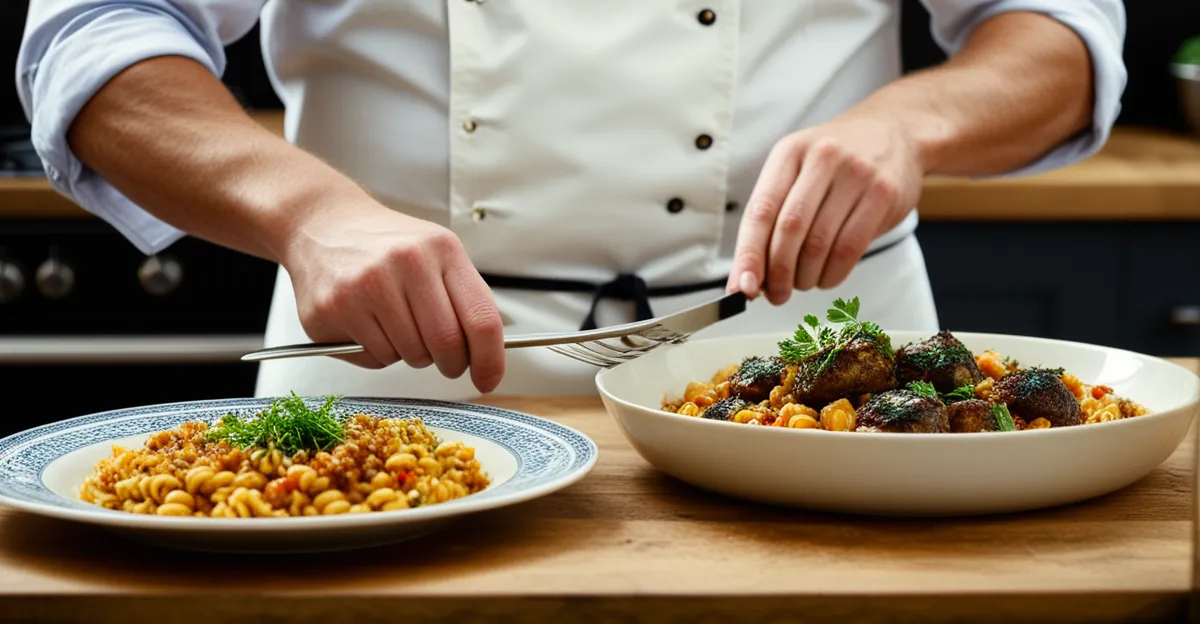Modernising UK Classics at Home
Modern British cooking at home thrives by balancing respect for tradition with fresh, innovative approaches. Updating classic UK recipes means understanding their core—whether it’s the comforting richness of a Sunday roast or the hearty simplicity of fish and chips—and then introducing subtle changes that enhance without overshadowing.
Innovative home cooking often involves rethinking ingredients or techniques while preserving the essence that makes traditional UK dishes beloved. For example, using locally sourced, seasonal produce can refresh a classic stew, or adding a hint of unexpected herbs can lift a familiar taste profile.
Also to see : How can you bake a perfect Victoria sponge cake?
Home cooks aiming to modernise British food benefit from acknowledging what makes these dishes iconic, like the texture of a sponge pudding or the savory depth of a proper pie. Innovation works best when it complements, not replaces, these defining features.
Striking this balance helps keep British culinary heritage alive while inviting new generations to enjoy it with a modern twist. Embracing innovation in home kitchens encourages creativity while honoring the history behind beloved recipes—creating dishes that feel both timeless and exciting.
In parallel : How Can Traditional UK Cooking Methods Enhance Modern Cuisine?
Creative Ingredient Swaps and Additions
When considering ingredient substitutions in modern British cooking, the goal is to meet dietary needs or introduce exciting new flavours without losing the distinctive qualities of traditional UK dishes. For instance, vegan shepherd’s pie replaces lamb with hearty lentils or mushrooms, preserving the dish’s comforting texture while catering to plant-based diets. This approach respects the original’s essence by maintaining its layered structure and rich depth.
Modern flavour pairings often emerge by incorporating global influences thoughtfully. Adding warming spices like smoked paprika or fresh herbs such as rosemary and thyme to classic stews can brighten the palate and create subtle complexity. These additions keep the dish rooted in British heritage while refreshing its character.
Healthy adaptations also play a role. Swapping cream for Greek yogurt in sauces or using vegetable stock instead of meat stock lightens dishes without compromising on savoury impact. Such changes enable home cooks to enjoy beloved classics with greater nutritional awareness.
By experimenting with ingredient substitutions and creative additions, home cooks can navigate the fine line between innovation and tradition, crafting dishes that are both familiar and intriguingly new. This balance honours the rich history of British cuisine while embracing contemporary tastes.
Contemporary Cooking Techniques
Modern British cooking at home benefits greatly from adapted cooking methods that enhance traditional UK dishes without compromising their character. Techniques like sous vide enable precise temperature control, ensuring meats for a Sunday roast stay tender and juicy, elevating texture beyond conventional roasting. Meanwhile, air frying offers a healthier alternative for crispy favourites like fish and chips, reducing oil usage while maintaining that satisfying crunch.
Utilising modern kitchen tools can streamline preparation. Slow cookers, for example, simplify long-simmered stews, allowing flavours to meld effortlessly with minimal active cooking time. Likewise, food processors speed up chopping and pureeing, making it easier to incorporate fresh herbs or create smooth sauces integral to British classics.
Adapting recipes with these techniques impacts both presentation and taste. Sous vide enhances moisture retention; air frying provides crispness without greasiness; slow cooking deepens flavour complexity. Understanding these effects helps home cooks confidently blend innovation with tradition, preserving the essence of each dish while embracing contemporary conveniences.
By integrating recipe adaptations that harness modern kitchen technology, home cooks can maintain the beloved qualities of British food while enjoying improved textures, flavours, and efficiency in their cooking process.
Chef-Driven Inspiration and Food Trends
Exploring chef inspiration provides valuable insight into how British food trends evolve by reimagining traditional UK dishes with fresh creativity. Many chefs embrace fusion cuisine, blending classic British comfort food with international flavours to craft bold, innovative plates. For example, introducing Asian spices into a traditional pie or transforming fish and chips with global dipping sauces reflects this trend.
Plant-based twists are a significant part of modern British food trends. Chefs often reinterpret familiar recipes using vegetables, legumes, and meat alternatives, appealing to wider dietary preferences while maintaining core flavours. This approach highlights how chef inspiration can guide home cooks in making contemporary yet authentic meal choices.
Street food reinterpretations also influence home kitchens, encouraging quick, flavour-packed adaptations. Observing such trends helps home cooks understand how to balance tradition and novelty practically.
To benefit from restaurant creativity, home cooks can study menus, cooking shows, or interviews, drawing ideas for ingredient combinations and presentation. This connection to current British food trends fosters confidence in experimenting, ensuring dishes remain engaging but still rooted in the nation’s rich culinary heritage.
Personalising Favourites and Testing New Ideas
Encouraging recipe experimentation is vital for modern British cooking at home. Personalisation allows home cooks to adapt traditional UK dishes to their tastes while preserving their core identity. For example, adjusting seasoning levels or adding a unique herb blend can refresh a classic Sunday roast without overwhelming its essence.
To build confidence, start small by tweaking one element at a time—such as swapping a standard side for a seasonal vegetable or experimenting with plating styles for visual appeal. These customisation tips help maintain balance between innovation and tradition, ensuring dishes remain recognisable yet exciting.
Recording successful variations is important. Keeping a cooking journal or recipe file helps refine ideas over time, making it easier to recreate and improve upon creative twists. Sharing these innovations with family or friends provides valuable feedback, fostering a supportive environment for culinary creativity.
Home cook creativity thrives when experimentation is encouraged alongside respect for British food heritage. This approach lets cooks explore fresh combinations and presentation styles, turning beloved classics into personalised delights that celebrate both history and innovation in equal measure.







